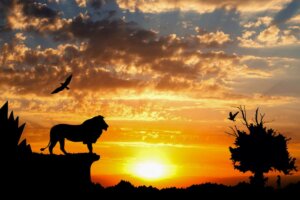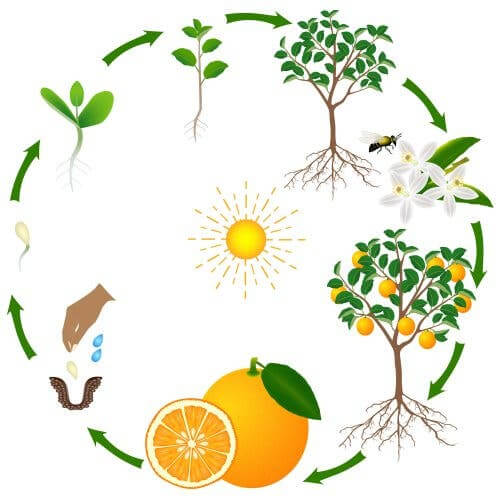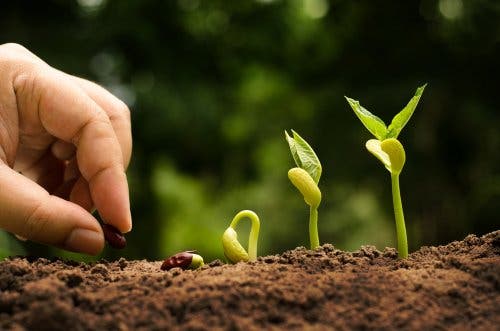How to Explain the Circle of Life to Children


Written and verified by the biologist Olga Carbajo
When think about explaining the circle of life to children, most of us picture the famous scene from the beginning of The Lion King. We imagine Mufasa presenting his heir, Simba, to the entire animal community. The song that’s playing is “The Circle of Life” and it refers to that endless cycle of life and death. On many occasions, it can be hard for children to grasp and accept this concept.
Parents and teachers often have a hard time explaining the circle of life to children. Just the same, it’s of vital importance if we want them to understand that death is just another part of life. Of course, the eternal question that parents ask themselves is “at what age should we start talking about this issue with our kids?”
The truth is, there’s no right answer to that question. It depends on the maturity and readiness of each child, as well as the personal circumstances in his or her life. Perhaps the death of a pet is a good time to talk about the circle of life. Therefore, we can also take advantage of this emotional distancing with nature to offer an example of how to explain the circle of life to children.
How to explain the circle of life to children: What is it?
In the field of biology, the circle of life, or the life cycle, is a natural process that governs the lives of all living beings. And this cycle consists of 4 different phases: Birth, development, reproduction, and death.
More than life, this final phase is the hardest to explain, given the negative connotations that death carries for us. However, in nature, on many occasions, death is synonymous with life. That’s because, when one cycle ends, another one begins.

The birth and development of a new being
Let’s take a close look at each of the phases in the circle of life. To do so, we’ll examine the simple example of a tree in order to better understand the concept of “resurrection”:
- Birth: This is the emergence of a new being in nature. There are many different types of birth, and some start with a seed, as is the case of our tree. In other cases, like starfish, birth begins with the piece of another being. And, of course, in many cases, creatures are born from a mother.
- Development: From that point on, this new being must grow. In multicellular organisms, this involves an increase in the number of cells and the acquisition of new structures or abilities. In unicellular organisms, maturity occurs almost at the same time as birth.
“Nature never hurries: atom by atom, little by little, she achieves her work.”
– R.W. Emerson –
How to explain the closing of the circle of life to children
In the beginning, our tree will be nothing more than a small, insignificant sapling. However, with the passing of time, it will become a lavish tree specimen that could measure as much as over 300 feet tall. Such is the case with some sequoia in California.

- Reproduction: Just like birth, there are several types and subtypes of reproduction in nature: Sexual and asexual. In the case of our tree, reproduction takes place through seeds. A grain of pollen travels by air and falls on the cones of a flower. It then fertilizes the flower’s ovule, thus creating our seed.
- Death: Several layers of protection will cover the seed, forming a fruit that will mature and serve as food for various animals. In a manner of speaking, this represents death, since the tree’s fruit has been destroyed and, with the passing of time, it will disappear.
“It’s the circle of life and it moves us all, through despair and hope, through faith and love. ‘Til we find our place on the path unwinding, in the circle, the circle of life.”
– Elton John (The Lion King) –
However, nature isn’t as cruel as it seems and the circle of life must continue. Seeds are strong, just like baby animals, and some survive fires, the dangers of other animals, gastric juices… And, in the end, back in the ground, with a little bit of sun and water, they germinate. A new plant is born and, who knows? With the passing of time, it may produce another tree that grows over 300 feet tall and lives for over 2000 years.
And finally, an experiment!
To reinforce your explanation of the circle of life to children, you can use this experiment. Grab a few seeds you have at home. For best results, use pinto or garbanzo beans. Then, place them in a bit of damp cotton inside a yogurt container. A few days later, they’ll start to produce their first roots. This marks the beginning of a new life. Now, all you need to do is plant it in some dirt and your children will see how the circle of life continues.
“It is as natural to die as to be born; and to a little infant, perhaps, the one is as painful as the other.”
– Francis Bacon –
When think about explaining the circle of life to children, most of us picture the famous scene from the beginning of The Lion King. We imagine Mufasa presenting his heir, Simba, to the entire animal community. The song that’s playing is “The Circle of Life” and it refers to that endless cycle of life and death. On many occasions, it can be hard for children to grasp and accept this concept.
Parents and teachers often have a hard time explaining the circle of life to children. Just the same, it’s of vital importance if we want them to understand that death is just another part of life. Of course, the eternal question that parents ask themselves is “at what age should we start talking about this issue with our kids?”
The truth is, there’s no right answer to that question. It depends on the maturity and readiness of each child, as well as the personal circumstances in his or her life. Perhaps the death of a pet is a good time to talk about the circle of life. Therefore, we can also take advantage of this emotional distancing with nature to offer an example of how to explain the circle of life to children.
How to explain the circle of life to children: What is it?
In the field of biology, the circle of life, or the life cycle, is a natural process that governs the lives of all living beings. And this cycle consists of 4 different phases: Birth, development, reproduction, and death.
More than life, this final phase is the hardest to explain, given the negative connotations that death carries for us. However, in nature, on many occasions, death is synonymous with life. That’s because, when one cycle ends, another one begins.

The birth and development of a new being
Let’s take a close look at each of the phases in the circle of life. To do so, we’ll examine the simple example of a tree in order to better understand the concept of “resurrection”:
- Birth: This is the emergence of a new being in nature. There are many different types of birth, and some start with a seed, as is the case of our tree. In other cases, like starfish, birth begins with the piece of another being. And, of course, in many cases, creatures are born from a mother.
- Development: From that point on, this new being must grow. In multicellular organisms, this involves an increase in the number of cells and the acquisition of new structures or abilities. In unicellular organisms, maturity occurs almost at the same time as birth.
“Nature never hurries: atom by atom, little by little, she achieves her work.”
– R.W. Emerson –
How to explain the closing of the circle of life to children
In the beginning, our tree will be nothing more than a small, insignificant sapling. However, with the passing of time, it will become a lavish tree specimen that could measure as much as over 300 feet tall. Such is the case with some sequoia in California.

- Reproduction: Just like birth, there are several types and subtypes of reproduction in nature: Sexual and asexual. In the case of our tree, reproduction takes place through seeds. A grain of pollen travels by air and falls on the cones of a flower. It then fertilizes the flower’s ovule, thus creating our seed.
- Death: Several layers of protection will cover the seed, forming a fruit that will mature and serve as food for various animals. In a manner of speaking, this represents death, since the tree’s fruit has been destroyed and, with the passing of time, it will disappear.
“It’s the circle of life and it moves us all, through despair and hope, through faith and love. ‘Til we find our place on the path unwinding, in the circle, the circle of life.”
– Elton John (The Lion King) –
However, nature isn’t as cruel as it seems and the circle of life must continue. Seeds are strong, just like baby animals, and some survive fires, the dangers of other animals, gastric juices… And, in the end, back in the ground, with a little bit of sun and water, they germinate. A new plant is born and, who knows? With the passing of time, it may produce another tree that grows over 300 feet tall and lives for over 2000 years.
And finally, an experiment!
To reinforce your explanation of the circle of life to children, you can use this experiment. Grab a few seeds you have at home. For best results, use pinto or garbanzo beans. Then, place them in a bit of damp cotton inside a yogurt container. A few days later, they’ll start to produce their first roots. This marks the beginning of a new life. Now, all you need to do is plant it in some dirt and your children will see how the circle of life continues.
“It is as natural to die as to be born; and to a little infant, perhaps, the one is as painful as the other.”
– Francis Bacon –
All cited sources were thoroughly reviewed by our team to ensure their quality, reliability, currency, and validity. The bibliography of this article was considered reliable and of academic or scientific accuracy.
- MECD. (última consulta octubre 2019). Fecundación y Desarrollo: el reino animal y vegetal. [Proyecto biosfera del ministerio]. Recuperado de: recurusostic.educacion.es
- “Ciclo de vida”. En significados.com. Disponible en www.significados.com/ciclo-de-vida. Consultado: octubre de 2019. Última actualización: diciembre 2018.
This text is provided for informational purposes only and does not replace consultation with a professional. If in doubt, consult your specialist.








